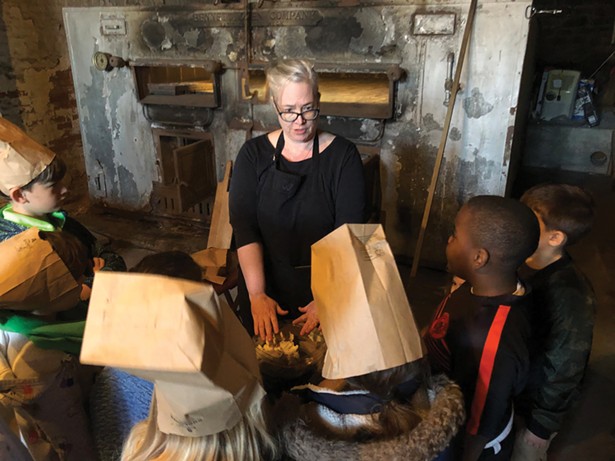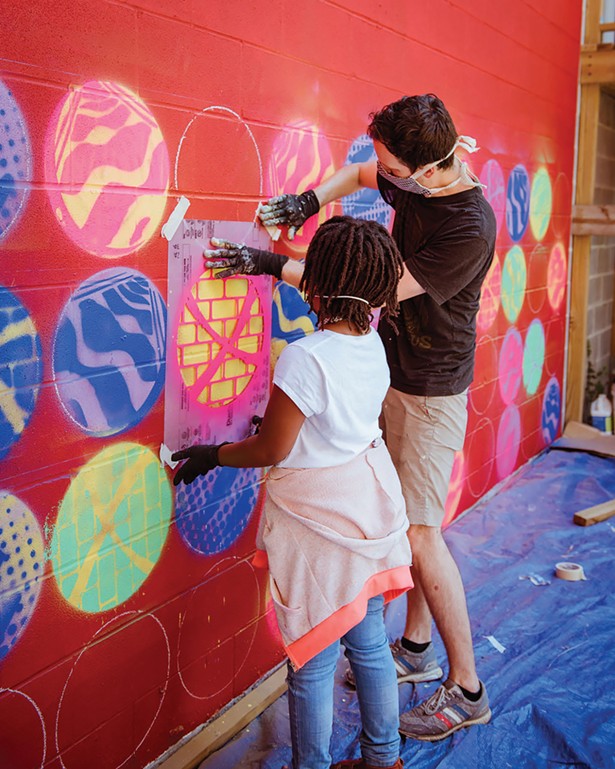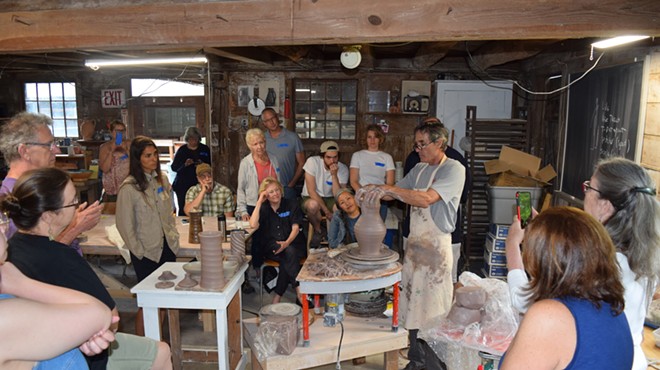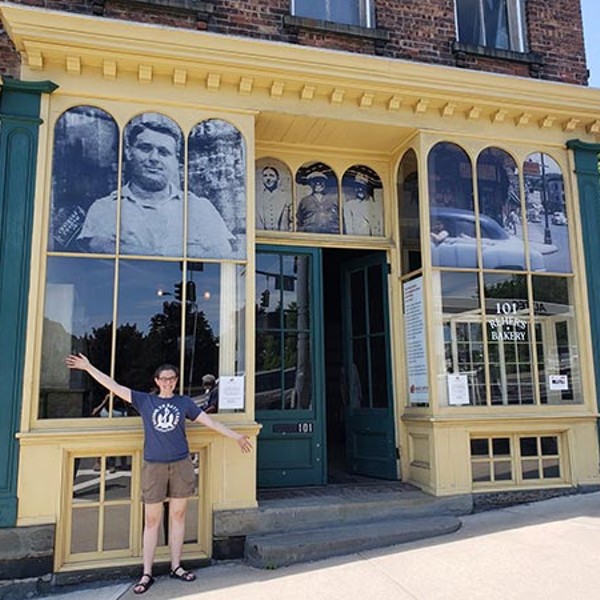
On the corner of Broadway and Spring Street in Kingston’s Rondout District is a 19th-century building that you can tell has a story about it, even from a quick drive-by. The first time I noticed it, I saw “Bakery” stickered in white on its windows but could tell there was more going on behind its green doors. Part of this is due to the black and white photos in the top arches of their window display and the buttercream-and-green-colored facade that stands out against the antiquated exposed brick of the rest of the building.
As an immigrant-owned Jewish bakery, it was a Kingston staple in the 1900s. Now, director Sarah Litvin hopes the Reher Center for Immigrant Culture and History becomes a space to celebrate diverse communities and cultures. The attractive new facade is no coincidence. Litvin says it’s an effort to use the exterior of the building to tell immigrants’ stories, not just because of COVID-based capacity limitations but also because they don’t have the resources to be open full-time.
The Bakery, Past and Present
The bakery’s history dates to 1908, when Frank Reher, a Jewish immigrant from Krakow (in Austria-Hungary, now Poland), founded it. Initially landing in New York City, Reher moved to Kingston with his wife and two daughters, but after having their third daughter, Reher’s wife passed away. In a year, Reher remarried. He had six children with his second wife, Ada. Together, they founded and ran the Reher Bakery.Hymie Reher, the last of the Reher family bakers, closed the bakery in the early '80s. The chain of events taking it from a state of disrepair to a lively new cultural center began in 2002, when historian Geoffrey Miller noticed the abandoned bakery, and mentioned it to his friend Barbara Blas, whose family happened to be longtime friends with the Rehers. After Reher’s passing in 2004, it was deeded to the Jewish Federation of Ulster County. The center as it stands today, a chartered museum in New York State, was Miller’s vision; he is now chairman of the center’s board of directors.

Litvin, who started her career as an oral historian, first heard about the project through her boss Annie Polland at the Tenement Museum on the Lower East Side. “I loved the vision,” Litvin says, “not just to preserve it, but to use it to tell the stories of immigrants in the Rondout neighborhood. And, to connect it, use it to bring newcomers together now.”
When she first walked into the bakery, Litvin looked around at shelves still brimming with the things left behind when it was shuttered, wondering what the story behind it all was. After speaking with people across Kingston, she pieced it together slowly, through their memories. “I discovered that the building itself told the story they were trying to tell,” Litvin says. “We’re talking about this specific family with this bakery here in Kingston. Still, there are so many ways folks can connect their own family stories to it,” she says.
Bakery Tours & Community Craft
Through the summer and autumn of this year, the center has hosted 45-minute tours of the historic bakery, where people get a peek into Sunday mornings back when it was buzzing with customers. The center chose to focus its tours on 1959—the height of its business in the multiracial, multiethnic working-class neighborhood. The area surrounding the bakery housed a diverse community, then mainly Irish, Italian, German, and Polish immigrants. “Every Sunday, people would go to church in the neighboring churches, then come to this kosher Jewish bakery. The stories I’ve been able to hear about it are so powerful.” she says.COVID restrictions last year became somewhat of a blessing, as she was also able to reach out to schools and do Zoom class presentations to showcase what the center was doing. And as a result, “Teachers are now on board with bringing their classes to us on field trips,” Litvin says.
One of the first teachers who approached the center, eager to bring her students in for a tour, was Ann Mino, a 7th/8th-grade teacher at Kingston Catholic school. As Litvin explains, “Each year, she said, she organized a field trip to New York City's Tenement Museum. When she heard that I had worked there and was developing an historic bakery tour based on the same storytelling model, she was thrilled at the prospect of bringing her students down the street rather than on an hours-long bus ride!”
In the autumn of 2019, the students were the first school group to tour the bakery on-site. Mino’s class also participated in the Stitched Together project in 2020. Now, the center has plans to work with other schools to develop a range of on-site school programming. “We have what it takes to create memorable, multisensory experiences that use a relatable, local story to help students make sense of core pieces of K-12 curriculum, including community, immigration, civic engagement, and so much more.” In August, the center received a two-year grant to work with a small group of 2nd- and 8th-grade teachers to pilot on-site school programming, which will launch in the fall of 2023.
The City as Character
Another project, Rondout Revisited, was a three-part exhibit, a great insight into the neighborhood in this city that played as important a role culturally as the bakery itself. Documenting the changes the area and its people went through over 150 years, it starts in 1820 when the Rondout was still Kingston Landing, running through to the urban renewal years in the ’60s.“We learn about the experience of running the bakery, then we end up thinking and talking about what happened through urban renewal, as the neighborhood lost not only its population but its social cohesiveness,” Litvin explains.
Litvin also wants to foster conversations about housing displacement. “Here we are in this neighborhood with a history of housing displacement because of urban renewal. And there’s so much relevance with what’s going on in the city right now,” she says. She adds that while urban renewal and gentrification contexts are different, there are ways to draw connections and learn from the past.
A Focus on Community
Since neither Litvin nor I grew up in Kingston, through much of our conversation we cycle through the idea of community. How do you find yours? What does it mean when you’re on the boundaries between different communities? Something the Reher Center wants to encourage is the idea that community doesn’t have to be based on a single identity group or geographical values.She mentions a series from 2019 called "The Spaces Between," a series of art, panel discussions, film screenings, and more, stemming from this idea of living on the boundaries, whether with immigrant status, racial identity, or having two or more cultural contexts in your life.
This month you can also see an installation from the center’s ninth annual Kingston Multicultural Festival’s cultural craft project, the “Worry Dolls Project/Proyecto Muñeca Quitapenas” on display in the front windows.
[embed-3] iLitvin is excited about the future, and particularly proud of a recent decision the board made to install an audio induction loop into the space. “We’re going to be the first site in Kingston to offer this built-in hearing access,” she says. They’re also planning a range of food programming, but if you’re looking to taste a slice of the past, you may have to wait a while longer; as Litvin explains, they don’t have the recipe for the renowned Reher Rolls, or a functional kitchen yet. She wants to work with former customers and bakers to serve fresh bread on future tours.
In March next year, the exhibit, “Sewing in Kingston: The Common Thread,” opens in the center's newly renovated gallery. “It explores how Kingstonians from many backgrounds have used sewing as a source of income, an expression of creativity, and a vehicle for cultural transmission,” she says. The facility is currently attempting to meet an end-of-year fundraising goal of $30,000. So, it’s a great time to show support by visiting or donating online.
For Litvin, at the end of the day, it’s most exciting to be able to continue to welcome folks into this community at the Reher Center, where she says, “There’s not a readymade community. We’re building it.”












